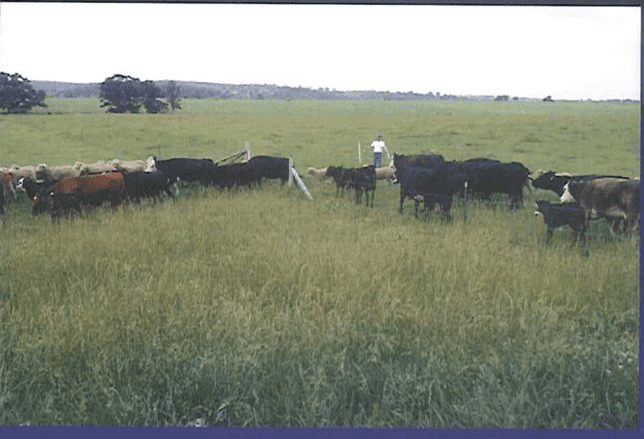Cattle getting out of where they’re supposed to be is costly no matter how one looks at it.
Thus, fencing is a key part of cattle management, according to Rod Schaub, Lyndon, Frontier Extension District livestock agent, who discussed alternative cross fence options during the Grazing Management Field Day at the Frank Graham farm, west of Garnett.
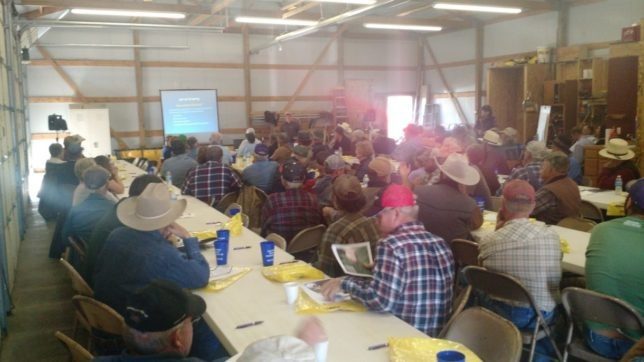
More than 100 producers from throughout eastern Kansas, at least ten counties, as well as western Missouri, attended the program sponsored by the Conservation Distracts and Natural Resources Conservation Service (NRCS) offices serving Anderson, Coffey and Linn County counties, said Debbie Davis at the Anderson County Conservation District office.
Cattle producers often query what the right fence is, and Schaub simply responded: “Any fence that keeps livestock where you want them.”
Yet, when cattlemen develop grazing systems to utilize stalk fields or rotate cattle on pastures, traditional barbed wire, woven wire or pipe often don’t work as efficiently as when used for pasture and corral fencing.
“An electric or power fence works well as a psychological barrier for these grazing systems,” said Schaub, who explained that power charged wires can also be effective as permanent fencing.
“Electric fencing is the least expensive, durable, easy to install and the most flexible,” he insisted.
“However, cattlemen have often had bad experiences with electric fence, because they don’t understand how the system works,” said Schaub, as he discussed procedures to make electric fencing enhancive to grazing systems.
An electric fence includes the charger, wire and of course the ground rod, Schaub demonstrated from a table filled with electric fencing “materials,” that those in attendance could evaluate and compare. “The charger, actually the energizer, is the first ingredient,” Schaub said.
A low-impedance charger was recommended for use, because they have a large reserve of current and are able to power charge very long fences, or fences that are overgrown by green growth.
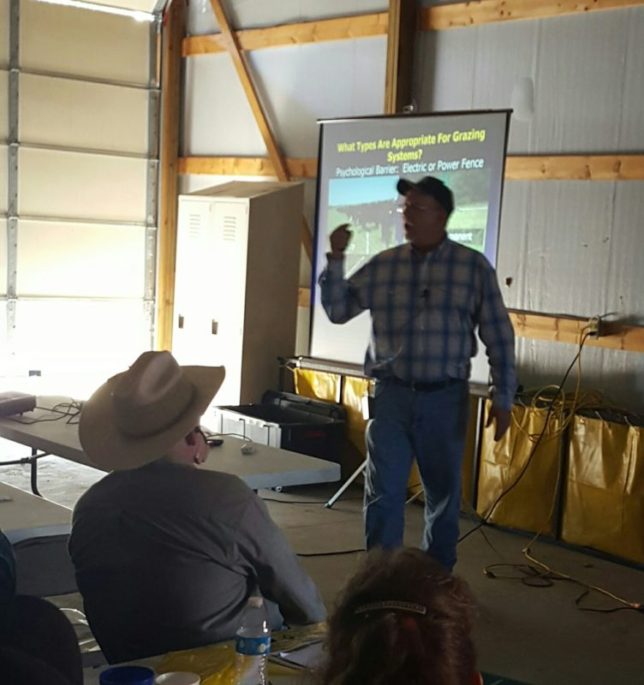
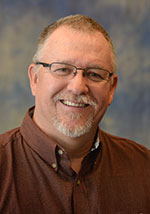
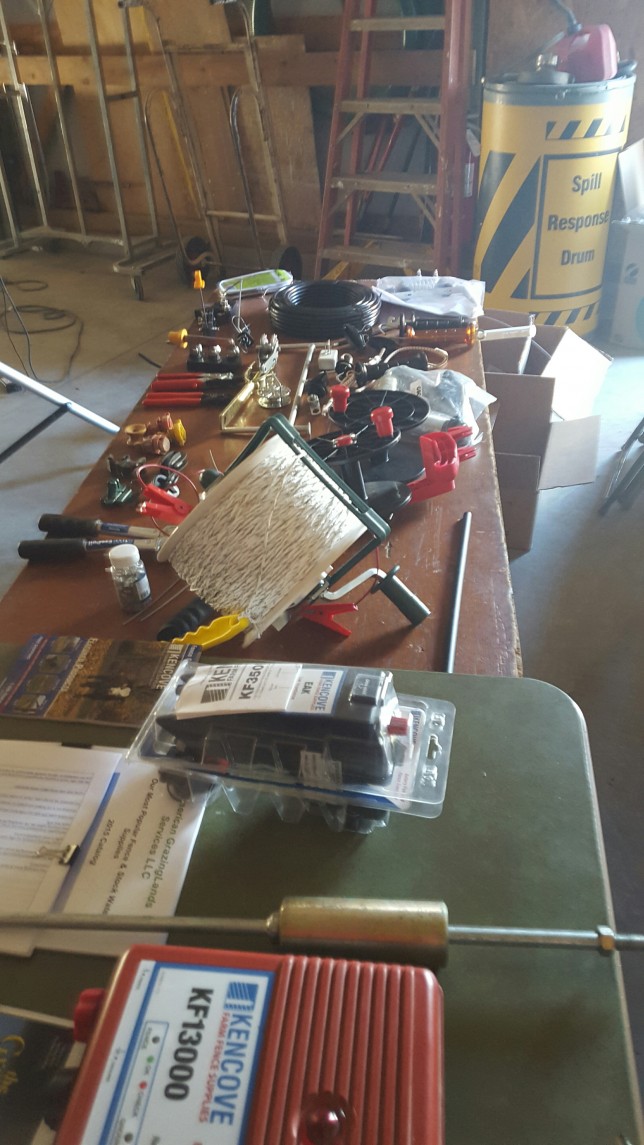
“Chargers should have a minimum of 5,000 volt output with a load, with 35 to 65 shock pulses per minute,” according to Schaub, who detailed the complexity that pulses should be “less than .0003-seconds long.”
Of course, it’s essential to know the miles and acreage to be fenced in order to buy a charger that will provide the service needed. It was like an electrician’s vocational technical school class to calculate the power requirements.
According to definition, a ‘”joule” is the measure of the “horsepower” of a shock pulse. It is the work required to produce one watt of power for one second. “Chargers should power one joule mile of fence under an average load,” Schaub deciphered for the attendees.
Power can be provided from a 110-volt electrical outlet, car battery or solar panel. “However, small solar energizer panels on chargers are inadequate,” Schaub warned.
“Electric energizers must be protected from weather elements, and a surge protector should be installed,” Schaub said.
The power surge protector is a simple device that goes between the plug and the receptacle to protect both the input (voltage source) and the output (fence) side of the energizer.
A lightning choke or induction coil is needed to protect the electric fence unit against over-voltage that can be caused by lightning strikes to the fence system.
“Lightning protection should be a minimum of 65 feet from the charger ground rods, yet there should be one more rod than charger ground,” Schaub said.
“Ninety percent of electric fence problems are from poor ground systems,” Schaub alerted.
It’s important to use galvanized ground rod, clamps and wire, but not mix metals, such as copper and galvanized, because this causes corrosion and poor conduction.
”All ground rods, connecting wire and clamps must be above ground, and at least 65 feet from the utility ground, well casing or other grounds,” Schaub explained.
It’s best to install the charger ground rods under fence lines or the drip edge of a building.
For a permanent fence, Schaub said to use 12.5-gauge high tensile Class 3 galvanized wire, 170,000 to 210,000 psi, defined as “pounds per square inch, of force that has to be applied to break it.”
“Wire under 200,000 psi is easiest to hand tie,” Schaub added.
Posts must be placed 40 to 50 feet apart on ground level, using insulators with a 10-year warranty. “Pin lock insulators are much easier to attach to high tensile wire than the claw type,” Schaub informed.
”Don’t hook insulators directly to trees,” he emphasized.
For portable fencing, poly wire can be purchased in braided or twisted form with six or nine strands of stainless steel, or mixed metals. “Mixed metals are more conductive, but the stainless steel strands won’t break as easy,” Schaub stated.
Wire is available on geared or standard reels, but Schaub suggested the “geared reels will make work much easier and faster.”
Many kinds of posts can be used in portable systems. “Choose a post for ease of use,” Schaub recommended. “A post with a large step and a small diameter rod is easiest to get into the ground.”
Floating angle braces are effective for one up to eight-wire fences, Schaub stated, but when a t-post is used, it’s only effective for one to two wire fences. A three-inch diameter post driven as deep as the amount of post above ground is effective for one to three wire fences, he said
When installing an electric gate, the hot wire should be buried in a non-metal pipe, 12 inches under the opening. “The gate won’t be hot when it’s unlooked,” said Schaub with a grin.
Flood gaps are always a major concern in fencing, so Schaub showed how an electric wire can be hung down from the fence line, with streamers made of galvanized chain, cable or 12.5 gauge wire. These are spread out six inches to a foot apart and dropped into the gap at least a foot about the water.
One slide showed a strip grazing fence charger attached to a barbed wire fence. “This is a bad idea for a couple of reasons. Electricity flows around the outside of wire, so at every barb tip, some electricity jumps off the fence, and you always want to keep the fence as hot as possible,” Schaub explained.
“But, maybe even a better reason not to electrify barbed wire using today’s low-impedance chargers is the possibility of you or your cattle getting caught on a barb and getting shocked numerous times,” said Schaub, adding: “Guaranteed if your wife is the one who gets caught on the barb, you’ll be sleeping in the barn.”
“Look around and learn from others before building your electric fence. Then, find a reputable dealer who knows their products and will stand behind them. Don’t cut corners,” Schaub demanded.
“Practice. Get your feet wet, but don’t touch the fence with wet feet,” the expert concluded.
